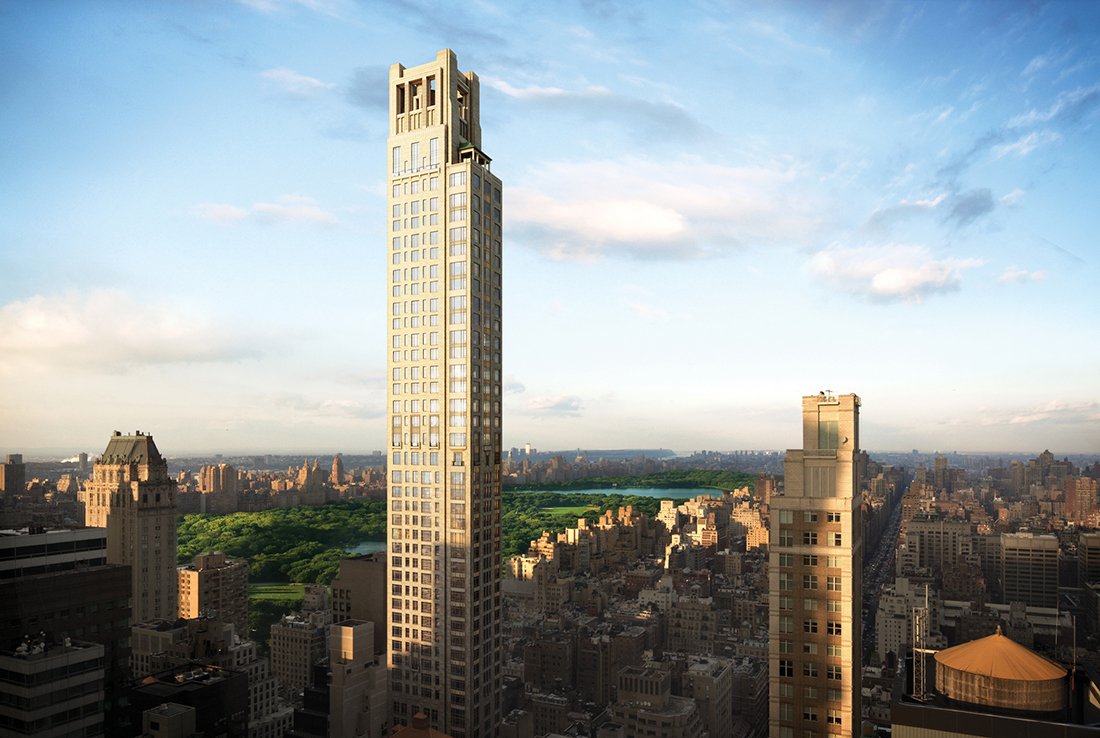Vornado Realty Trust is spending an extraordinary $5,000 per square foot to develop 220 Central Park South, the real estate investment trust disclosed Tuesday. That price tag includes $1,500 per foot for the land and $3,500 per foot in hard, soft and financial costs, according to Vornado CEO Steven Roth. “The building has the largest loss factor of any building of its type intentionally, so the amenity packages” – including multiple lobbies, a motor court, garage and swimming pools “are extraordinary and are catering to this marketplace,” he said. Roth also revealed that more than half of the building’s 118 units are in contract. Fourteen of the units went for north of $50 million, some with record-breaking price points, Roth added during the company’s third-quarter earnings call. “Our margins are superb and are holding with each sale,” he said. The total sellout for the luxury condominium project is nearly $3 billion, according to the Attorney General’s office. The Robert A.M. Stern-designed building has seven penthouses, including five units with price tags north of $50 million. Penthouse 73, a 9,500-square-foot condo asking $100 million, is reportedly in contract for more than $10,500 per foot. Two other penthouses, Penthouses 75 and 76, don’t have price tags, fueling speculation that they could be combined into a single, 14,000-square-foot mega-unit. Although buyers haven’t been disclosed, hedge funder Ken Griffin, founder and CEO of Citadel, is reportedly looking to combine multiple penthouses into a $200 million-plus pad. Previously, The Real Deal reported that a Qatari buyer was eyeing a $250 million spread. During the earnings call, Roth said domestic buyers comprise the majority of those scooping up units at 220 CPS. He said 45 percent of buyers are New Yorkers purchasing a primary residence and 30 percent are Americans living in other cities. In the third quarter, Vornado increased its construction budget at 220 CPS by $300 million to a total of $1.3 billion. “A lot of it is catching up the budget, which we should have done three months ago,” said Roth. “A lot of it is expansion of the program, adding cost, delivering more product, better finishes.” But Roth also said construction costs in New York are inflated because of the “enormous number of cranes” in the sky. “There are a handful of contractors who are experts in each trade [and] those guys are running out of capacity,” he said. “There is a bidding premium to get timely delivery of products and services.” Construction at 220 CPS is currently at the ninth floor and is expected to be completed in 2018. Earlier this week, Vornado secured a $750 million term loan for its luxury condo development. That financing came just two months after the REIT upsized its loan from Bank of China, receiving an additional $350 million for a total of $950 million. Tags: 220 central park south, Billionaires Row, luxury condos, Steven Roth, vornado realty trust Source: 220 Central Park South Sales | Vornado Realty Trust
Here's Why Buying in Manhattan Won't Get Easier Anytime Soon - Curbed NY
Despite the proliferation of new buildings and luxury condos throughout Manhattan, a new report by Crain's reveals that the number of rental units on the island is astronomically higher than the number of units for sale. That's not hyperbole: According to Crain's, in Q1 of 2015, there were 850,000 apartments in Manhattan, but only 5,200—or 0.6 percent—were for sale; plus, 75 percent of the borough's apartments are rental units. The piece breaks down why this is happening, and—spoiler!—the plethora of ultra-pricey apartments is playing a part in why inventory is so low, and prices are so high. Because so few apartments are for sale at any given time, developers and landlords can charge a pretty penny for them—it's that old rule of demand outpacing supply. The median sale price for a Manhattan apartment is close to topping $1 million, and it's unlikely that it'll go down anytime soon. But part of the problem is that it's so expensive to build in Manhattan—from securing air rights to getting the materials to hiring construction crews—that it's become difficult for developers to turn a profit. ("In 2014, the average cost of building an apartment was $585,370, three times what it was just seven years prior," according to Crain's.) That's how the firms behind buildings like One57, 432 Park Avenue, or Central Park Tower are able to command such high prices—and they have the ultra-rich buyers who will shell out up to $100 million for an apartment. But where does that leave those New Yorkers whose budgets are more modest? Sadly, they're pretty much screwed: Even with Mayor de Blasio's affordable housing push—which includes both sale and rental units—the number of cheaper apartments on the market isn't likely to change anytime soon. And "the days of landlords converting waves of rental units into co-ops or condos have long passed," according to Crain's. Better start looking in the outer boroughs if you hope to buy in the city anytime soon—or stick with renting. (Not that it's so simple to do that, especially when rental prices in Manhattan are rising faster than ever before.) Source: Here's Why Buying in Manhattan Won't Get Easier Anytime Soon - That's Rather Depressing - Curbed NY
NYC Marathon Street Closures Happening This Sunday - Curbed NY
This weekend, thousands of New Yorkers will take to the streets in ridiculous outfits for one of the city's biggest events—and no, we're not talking about theVillage Halloween Parade. The TCS New York City Marathon happens this Sunday, and with it comes a bevy of street closures that can make commuting more of a nightmare than normal. If you want to know which streets to avoid this weekend, read on—the full list of closures, per the DOT, is below. They'll be closed from 8am to 4pm, but keep in mind that during peak times, there are going to be more runners chugging along, and it may be all but impossible to get around. Don't say we didn't warn you.
Staten Island
· Bay Street between Richmond Terrace and School Road · School Road between Bay Street and Staten Island Expressway
Brooklyn
· Dahlgren Place between Verrazano Bridge and 92nd Street (North Bound) · 92nd Street between Dahlgren Place and 4th Avenue · 4th Avenue between 92nd Street and Flatbush Avenue · Flatbush Avenue between 4th Avenue and Lafayette Avenue · Lafayette Avenue between Flatbush Avenue and Bedford Avenue · Brooklyn Queens Expressway (South-bound) between Verrazano Bridge and 79th Street · 7th Avenue between 79th Street and 75th Street/Bay Ridge Parkway · 7th Avenue between 74th and 75th Street/Bay Ridge Parkway · 74th Street between 6th Avenue and 7th Avenue · 6th Avenue between 74th and 75th Street/Bay Ridge Parkway · Bay Ridge Parkway between 7th Avenue and 4th Avenue · 92nd Street between Gatling Place and Fort Hamilton Parkway · Fort Hamilton Parkway between 92nd Street and 94th Street · 94th Street between Fort Hamilton Parkway and 4th Avenue (North-bound) · 4th Avenue between 94th Street and Flatbush Avenue (South-bound) · Bedford Avenue between Lafayette Avenue and Nassau Avenue · Nassau Avenue between Bedford Avenue/Lorimer Street and Manhattan Avenue · Manhattan Avenue between Nassau Avenue and Greenpoint Avenue · Greenpoint Avenue between Manhattan Avenue and McGuiness Boulevard · McGuiness Boulevard between Greenpoint Avenue and 48th Avenue · Pulaski Bridge (South-bound)
Queens
· Pulaski Bridge (South-bound) · 48th Avenue between 11th Street and Vernon Boulevard · Vernon Boulevard between 48th Avenue and 10th Street · 10th Street between Vernon Boulevard and 44th Drive · 44th Drive between 10th Street and Hunter Street · Hunter Street between 44th Drive and Crescent Street · Crescent Street between Hunter Street and Queens Plaza South · Queens Plaza South between Crescent Street and 23rd Street · 23rd Street between Queens Plaza South and Queens Plaza North · Queensboro Bridge (East-bound)
Manhattan
· Queensboro Bridge (Vehicle Entrance Ramp East-bound) · East 59th Street between 59th Street Bridge and 1st Avenue · 1st Avenue between East 59th Street and Willis Avenue Bridge · Madison Avenue Bridge · 5th Avenue between 138th Street and 124th Street · 124th Street between Madison Avenue and Mount Morris Park West · Mount Morris Park West between 124th Street between 120th Street · 120th Street between Mount Morris Park West and 5th Avenue · 5th Avenue between 120th Street and 90th Street · 90th Street between 5th Avenue and East Drive (Central Park South-bound) · East Drive between 90th Street and Grand Army Plaza · Grand Army Plaza between East Drive and Central Park South · Central Park South btw 5th Avenue and Columbus Circle/8th Avenue/Central Park West · Central Park Driveway/8th Avenue Approach to West Drive · West Drive between 8th Avenue Approach and 96th Street Approach to West Drive · 96th Street Approach to West Drive · 67th Street Approach to West Drive
Bronx
· Willis Avenue Bridge/Willis Avenue · East 135th Street between Willis Avenue and Alexander Avenue · Alexander Avenue between East 135th Street and East 138th Street · East 138th Street between Alexander Avenue and Morris Avenue · Morris Avenue between East 138th Street and East 140th Street · East 140th Street between Morris Avenue and Rider Avenue · Rider Avenue between East 140th Street and East 138th Street · East 138th Street between Rider Avenue and Madison Avenue Bridge · Madison Avenue Bridge
· TCS NYC Marathon [Official]
Source: NYC Marathon Street Closures Happening This Sunday - Runner's Delight - Curbed NY
Hamptons Prices on the Rise as Sales Tumble - TheRealDeal

Even after a summer of sluggish sales, the Hamptons market is getting pricier.
Homes under $1 million in the tony beach community now account for just under 50 percent of the market, the lowest point in four years, according to the latest quarterly report from Douglas Elliman and appraisal firm Miller Samuel.
Homes over $5 million, meanwhile, now account for a larger piece of the pie at 44.4 percent, up nearly nine percent from last year.
But unlike last year’s frenzied summer sales season, buyers during this year’s third quarter didn’t rush to sign on the dotted line. Across the board, the number of sales during the third quarter plummeted 20 percent to just 507, according to the report, while inventory levels held steady compared to last year, with around 1,700 properties for sale.
Jonathan Miller, president of Miller Samuel and author of the report, said there were fewer sales because the market was returning to normal after the frenzy in 2013 and 2014, which reflected pent-up demand from the financial crisis. “In 2013 and 2014, we had record sales,” he said. “We’re coming down off that sugar high.”
Despite the slow pace of sales, the median sales price jumped 9.8 percent to $950,000, and the average sales price remained relatively unchanged at $1.7 million, according to the report.
Miller said the lower end of the market drove the overall price growth, said Miller. The median price for home sales under $1 million rose 10.2 percent to $567,000. By contrast, the median price for homes between $1 million and $5 million only increased 1.3 percent to $1.9 million. “
During the third quarter, there were just 31 sales of homes $5 million and up, the lowest number in two years.

The entry threshold for the luxury market also dropped nearly 4 percent to $3.7 million. And the median sales price in the luxury market – defined as the top 10 percent of sales – plummeted 18 percent to $5.3 million, while the average sales price dropped 15 percent to $7.1 million.
With prices softening, inventory also piled up. There were 292 homes for sale during the third quarter, a nearly 34 percent jump from last year.
- See more at: http://therealdeal.com/blog/2015/10/23/hamptons-prices-on-the-rise-as-sales-drop/#sthash.uctAotBf.dpuf
Looking For Something To Do This Weekend? 6 Pumpkin Patches Near NYC - Curbed NY

There's something deeply satisfying about visiting a pumpkin patch come October, whatever your age. And just because you're without a car doesn't mean you can't plan this fall excursion. These are the six best pumpkin patches to visit throughout New York State—with a few right here in the city—that you can get to via public transportation.
 [Queens County Farm Museum via Facebook]
[Queens County Farm Museum via Facebook]
↑ The easiest trip in search of pumpkins is the one to the Queens County Farm Museum, in Little Neck, Queens. This 47-acre farm—New York City's largest remaining tract of undisturbed farmland—is open weekends in October with a variety of fall activities. There is no admission fee to walk through the pumpkin patch (although the pumpkins will cost you), and you can also pick up Hudson Valley apples, fresh cider, and locally-made treats. Other autumnal activities include a three-acre corn maze, a haunted house, and a kiddie festival on Sunday, October 25.
How to get there: Take the E or F train to Kew Gardens/Union Turnpike Station, then transfer to Q46 Bus (running eastbound on Union Turnpike) to the Little Neck Parkway stop. Cross Union Turnpike and walk north on Little Neck Parkway three blocks to the museum entrance.
 [Decker Farm via Historic Richmond Town]
[Decker Farm via Historic Richmond Town]
↑ Decker Farm is another pumpkin-picking spot that's NYC-based, albeit on Staten Island at Historic Richmond Town. The 1810-era farm, which includes 11 structures on 11 acres of land, hosts pumpkin pickers every weekend through November 1. On top of the pumpkin patch, you can join a hayride, tour the farmhouse, or navigate a corn maze.
How to get there: From the Staten Island Ferry Terminal in St. George, take the S74 bus to Richmond Road and St. Patrick's Place.
 [Harvest Moon Farm via Facebook]
[Harvest Moon Farm via Facebook]
If you'd rather go pumpkin picking upstate, there are plenty of options. Both Outhouse Orchards and Harvest Moon Farm and Orchard (↑) in North Salem are accessible from the MetroNorth. Despite its less-than-pleasant name, Outhouse is a scenic family-owned and operated apple orchard that hosts pumpkin picking in the fall. There's also a corn maze, hay ride, and a farmstand selling apples, produce from the farm, local honey, and maple syrup.
Right across the street from Outhouse is Harvest Moon Farm, which hosts a fall festival every weekend through October. For a $5 admission, there's a pumpkin patch, live music, a kid's bounce house, hay rides, pony rides, face painting, and BBQ. For the adults, a hard cider tasting room also opens up on weekends.
How to get there: Take the Metro North from Grand Central to the Croton Falls station. On weekends, cabs are usually waiting to take patrons three miles to either farm.
 [Dee's Nursery via the website]
[Dee's Nursery via the website]
↑ From the Long Island Railroad, Dee's Nursery is the most accessible fall destination from any train stop. This family-owned nursery and garden center hosts a festival every weekend in October with a pumpkin patch, petting zoo, and kid's crafts. The only caveat: you won't get the farm backdrop.
How to get there: Take the Long Island Railroad toward Long Beach and exit at theEast Rockaway stop. From there, it's about a 15 minute walk east to the nursery.
 [Masker Orchards by tciriello via Flickr Creative Commons]
[Masker Orchards by tciriello via Flickr Creative Commons]
↑ Masker Orchards, located upstate in Warwick, has been home to apple orchards in the Hudson Valley for more than 100 years. It's open five days a week with a pick-your-own pumpkin patch, an Apple Maze, and a haunted house through Halloween. Other events, offered on weekends, include face painting, pony rides and live music. Be sure to stop by the county store to pick up apple butter, fresh jam, or honey before you leave.
How to get there: Take the New Jersey Transit bus #196 or #197 from Port Authority to the Willowbrook Station in Warwick. Masker Orchard is a half mile walk from the station.
Source: 6 Pumpkin Patches Near NYC You Can Reach By Public Transit - Get Outta Town - Curbed NY
3 Starter Apartments Priced Under $700k to See This Weekend - Midtown East - DNAinfo.com New York
By Emily Nonko | October 15, 2015 5:54pm

3 Starter Apartments Priced Under $700k to See This Weekend
MANHATTAN — On the lookout for a starter apartment in Manhattan? These three one-bedroom co-ops are all priced reasonably and have open houses this weekend.
320 East 42nd St., #2009, Midtown East One bedroom/One bath Approximately 650 square feet Co-op $645,000 Maintenance: $1,423 a month Open House: Sunday, Oct. 18, 12 p.m. to 1:30 p.m.
Lowdown: Although this apartment is legally a one bedroom, a renovation left it feeling more like a loft.
“The owner gut renovated the entire apartment,” said Douglas Elliman broker Dylan Hildreth-Hoffman. “It feels like a SoHo loft instead of a stuffy one bedroom.”
It is, admittedly, a “SoHo loft in small form,” said Hildreth-Hoffman. But without the bedroom wall, there is still a larger, more open living space in this apartment compared with other apartments in the building. The current owner built out a Murphy bed, which is separated from the living room by a curtain.
The renovation, which happened about six years ago, also included a new kitchen and bathroom.
The apartment is distinguished by its large lattice windows, which are part of the building's landmarked facade. The co-op plans to upgrade and soundproof the windows within the next 12 months, according to Hildreth-Hoffman.
Other perks include a walk-in closet and impressive views.
“You're on the 20th floor of the building, so you get a birds-eye view of 42nd Street,” said Hildreth-Hoffman. “It feels like the Chrysler Building is in your living room.”
Location: 320 East 42nd Street — also known as the Woodstock Tower — is the tallest building within the Tudor City complex. Located about a block from the East River, Tudor City is known for its co-op buildings with modest apartments at reasonable prices. Given that the complex is near the United Nations, Hildreth-Hoffman thought this may be the ideal apartment “for an oversees visitor.” The building allows residents to rent out their apartments if they're not staying full-time. For train access, it is about three long blocks from the Grand Central transportation hub.
Why put it on your open house calendar? “It's one-of-a-kind,” said Hildreth-Hoffman. “You've got light, the views, and an impeccable renovation.”
420 East 51st Street, #4H, Midtown East One bedroom/one bath Approximately 900 square feet Co-op $395,000 Maintenance: $2,646.88 a month Open House: Sunday, Oct. 18, 11:30 a.m. to 1 p.m.
Lowdown: Although this apartment is located in a post-war co-op building, the seller renovated it and added some pre-war-inspired details.
The oak floors were stained and moldings were added, according to Halstead broker Eva Gellin. The kitchen and bathroom were gut renovated, with a new shower and marble details in the bathroom and new granite counters and cabinets in the kitchen.
“The kitchen is unique because it's wide, with two huge windows,” said Gellin. The windows look north, offering views of neighboring townhouses.
An L-shaped dining room is adjacent to the kitchen, and opens up into a living room space. From the living room, a small foyer leads to the bedroom.
“It's a very spacious bedroom, with views of the treetops outside,” said Gellin.
The apartment is located on the fourth floor of the 13-story building. Because it is a land lease building, in which shareholders pay rent for the land the building occupies, maintenance is high.
“The high maintenance can be difficult for young buyers,” Gellin said. “That's why the price is so low.”
Location: This co-op building is located on the very eastern edge of Midtown, between First Avenue and FDR Drive. Although the area is quiet, there are a number of bars and restaurants nearby along Second and Third avenues. The Lexington Avenue 6 train and the E and M trains at Lexington Avenue and 53rd Street are three long avenue blocks away.
Why put it on your open house calendar? “The space and the condition of the apartment,” said Gellin, who thought the size of the bedroom, living room and kitchen was “wonderful for a one bedroom."
179 East 79th Street, #2D, Upper East Side One bedroom/One bath Co-op Approximately 800 square feet $669,000 Maintenance: $1,763 a month Open House: Sunday, Oct. 18, 2:30 to 4:00 p.m.
Lowdown: Stribling broker Julie Perlin called this a “special starter apartment” due to its location in the Upper East Side.
“There are lots of bedrooms to buy under $700K east of Third Avenue,” she said. “But there are not many west of Third Avenue to Park, where this is located.”
179 East 79th St. is a pre-war co-op building with 16 stories and four apartments per floor. There's a full-time doorman, live-in super and private garden for residents. This unit is located on the second floor in the back of the building, “so it's quiet,” said Perlin.
It has “charming pre-war details,” she noted, including arched entryways and moldings. The living room is large enough for both a seating and dining area.
The seller, who is a long-term resident of the co-op, updated both the kitchen and the bathroom. The apartment has a galley kitchen and the seller had enough room to build out an office nook at the end of it, according to Perlin.
“It's a spacious kitchen,” she said. “There's also a window near the office nook to bring in light.”
Location: This building is located between Third Avenue to the east and Lexington Avenue to the west. It's only about three blocks away from Central Park and the Metropolitan Museum of Art. When it comes to transportation, you could take the 77th Street 6 train, two blocks away, or the 4 or 5 trains at 86th Street, six blocks away.
Why put it on your open house calendar? “It's the best value for a pre-war one bedroom in the neighborhood, west of Third Avenue,” said Perlin.
Source: 3 Starter Apartments Priced Under $700k to See This Weekend - Midtown East - DNAinfo.com New York
Robert A.M. Stern's 520 Park Avenue Finally Reaches Street Level, $130M Penthouse On Its Way - 6sqft
Two years since its groundbreaking, Zeckendorf Development’s tower o’ opulence at 520 Park Avenue has finally emerged from its cavernous trench. Set for completion in 2018, the Billionaires’ Row building will climb 54 floors and 780 feet into the Manhattan skyline, becoming the tallest and likely the most prestigious building on the Upper East Side. Envisioned by William Lie and Arthur Zeckendorf, 520 Park Avenue inherits the classically-inspired taste of the real estate dynasty’s prior projects. In the ’80s, their father William Zeckendorf Jr. erected some of the city’s largest post-modern apartment complexes such as Worldwide Plaza, Zeckendorf Towers, and the Park Belvedere. Here, the developers commissioned the esteemed architect/historian and dean of the Yale School of Architecture Robert A.M. Stern as the designer and SLCEas the architects of record. This team also collaborated together on 18 Gramercy Park South and 15 Central Park West, which shattered apartment records when opened in 2008. Intent on replicating its west side counterpart’s success, the Zeckendorfs again gathered the now-not-so-secret ingredients: a powerful address, palatial apartments, and most importantly, the coveted Central Park view, all of which will culminate in a jaw-dropping $130 million penthouse.
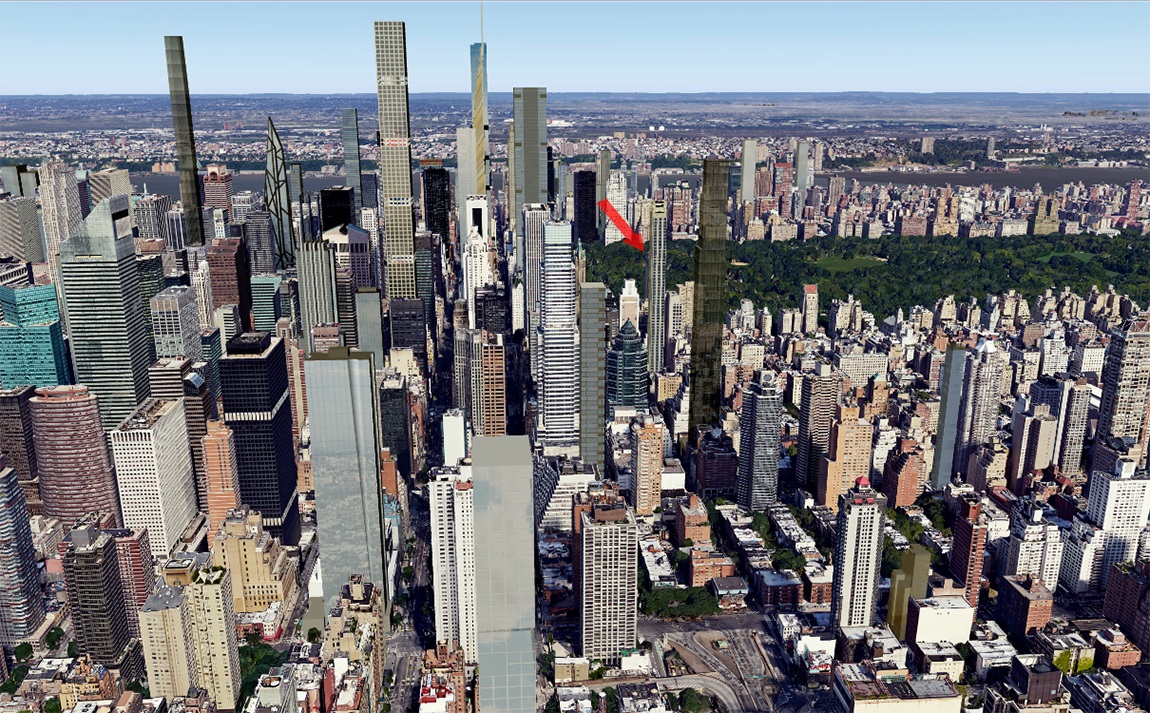 Aerial renderings via CityRealty
Aerial renderings via CityRealty
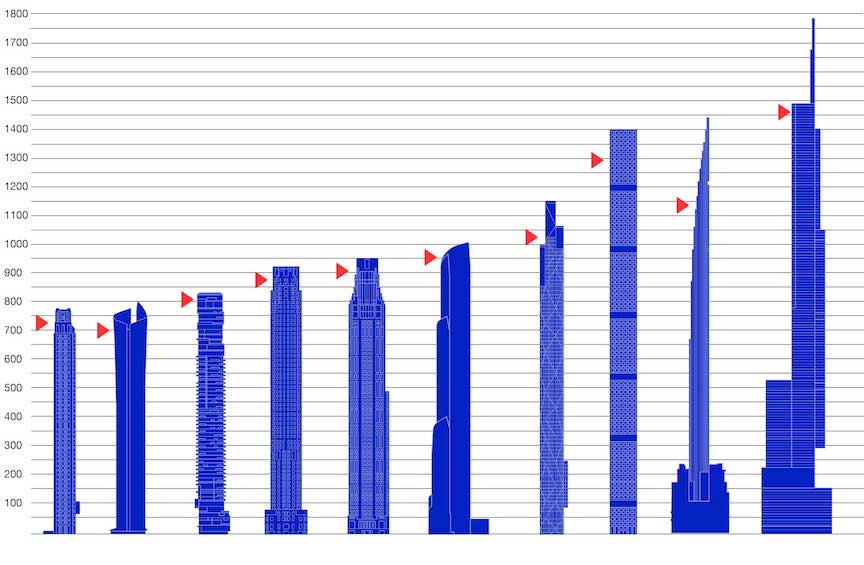 Diagram of the tallest current and upcoming slender skyscrapers in New York City. From left: 520 Park Avenue, 111 Murray Street, 56 Leonard,30 Park Place, 220 Central Park South, One57, 53W53, 432 Park Avenue, 111 West 57th Street, and Central Park Tower. Image courtesy of the Skyscraper Museum
Diagram of the tallest current and upcoming slender skyscrapers in New York City. From left: 520 Park Avenue, 111 Murray Street, 56 Leonard,30 Park Place, 220 Central Park South, One57, 53W53, 432 Park Avenue, 111 West 57th Street, and Central Park Tower. Image courtesy of the Skyscraper Museum
Mirror, mirror on the wall, who’s the slenderest of them all? The project site is only 60 feet wide, making 520 Park among the most slender skyscrapers in the city. Despite its Park Avenue address, the building is actually tucked midblock along 60th Street behind Christ Church, to which the project owes its address and air rights. To garner more floor area, the building will cantilever over much of the adjacent Grolier Club, capturing an additional 30 feet of width.
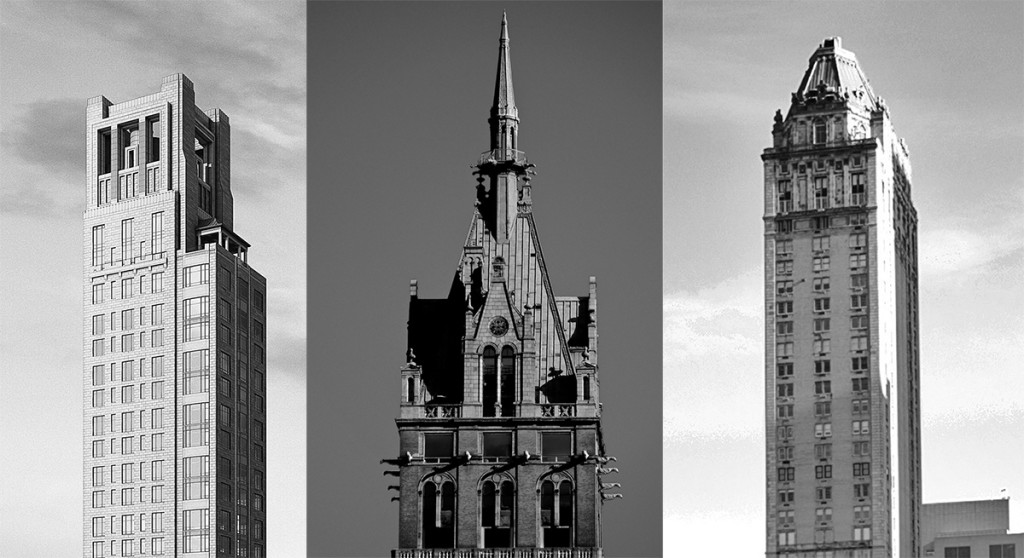 From Left: 520 Park Avenue, Sherry-Netherland, and the The Pierre
From Left: 520 Park Avenue, Sherry-Netherland, and the The Pierre
The tower will rise in relative isolation, roughly to the same height as the Woolworth Building downtown. Nearly all of the building’s 33 full-floor residences will posses views of Central Park since the site lies just outside of Midtown’s canyons and overlooks the protected Upper East Side Historic District. The tower’s cladding of warm Indiana Limestone is designed to soak up natural light and be evocative of the great New York apartment buildings of the 1920s and ’30s. At its pinnacle is a $130 million, three-level, 12,400-square-foot shrine of wealth. Its crown of four corner chimneys strung together by sets of pilasters, will join the fairytale tops of the Pierre and the Sherry-Netherland nearby.
Homes begin 170 feet up and cover a minimum of 4,600 square feet of. Amenities include a landscape courtyard, guest suites, private wine cellars, a bi-level health and fitness center, a swimming pool and spa, children’s playroom, and a screening area. Prices begin at $16 million and as 6sqft first reported last March, the developers are projecting a total sellout of $1.2 billion. The $130 million triplex penthouse was the most expensive apartment to hit the market. However, the three top floors of 220 Central Park South(another Billionaires’ Row tower designed by Robert A.M. Stern), is reported to be in contract for a whopping $200 million by billionaire hedge fund manager Kenneth Griffin.
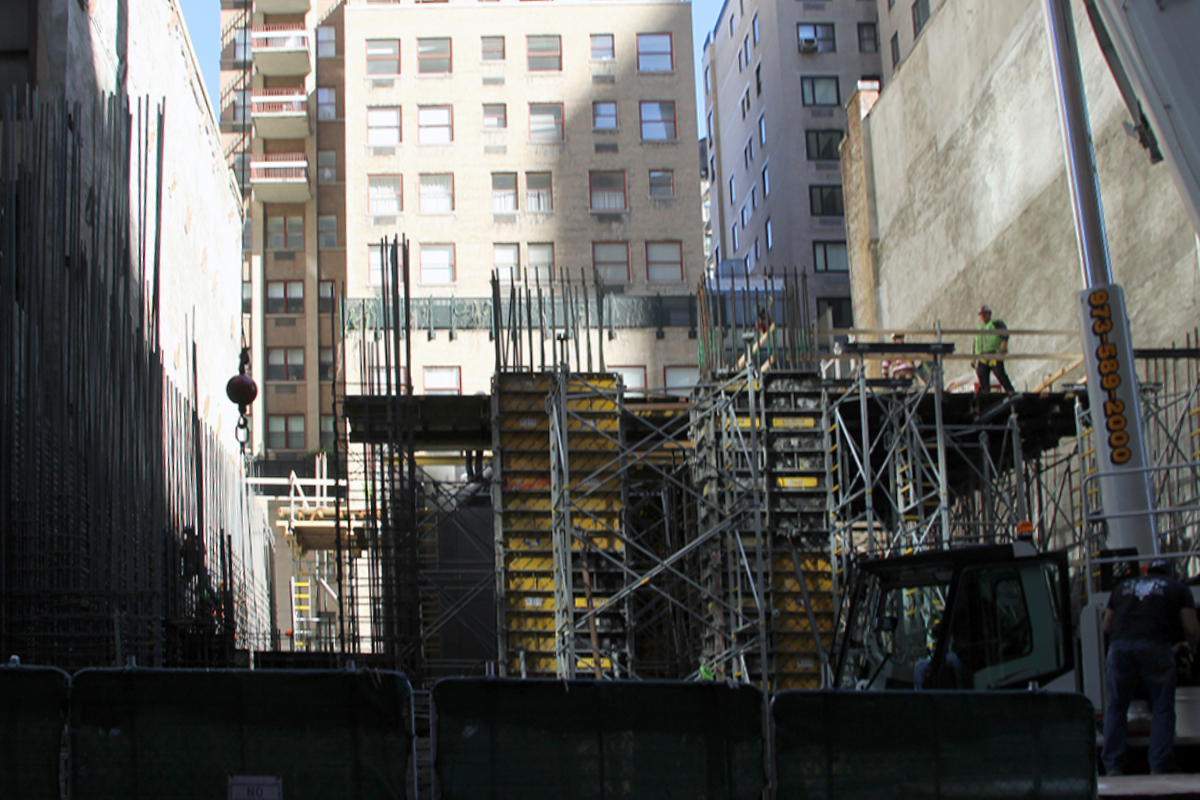 The construction site as of this week, via CityRealty
The construction site as of this week, via CityRealty
In a recent CNBC interview regarding the development, William L, Zeckendorf told media outlet that they’ve seen more Chinese buyers in the last 60 days than ever before. He also notes, “Probably more likely now than ever. We are seeing more and more interest in New York City from across the world, we’re also seeing record-breaking prices being paid by New Yorkers.”
Source: Robert A.M. Stern's 520 Park Avenue Finally Reaches Street Level, $130M Penthouse On Its Way | 6sqft
Inside 432 Park Avenue - Deborah Berke discusses her design philosophy behind 432 Park Avenue
 Deborah Berke discusses her design philosophy behind the residences at 432 Park Avenue. The recently appointed Dean of the Yale School of Architecture explains her vision to balance the scale and beauty of the windows with a layout that flows naturally from grand spaces to intimate spaces.
Deborah Berke discusses her design philosophy behind the residences at 432 Park Avenue. The recently appointed Dean of the Yale School of Architecture explains her vision to balance the scale and beauty of the windows with a layout that flows naturally from grand spaces to intimate spaces.




Source: Deborah Berke discusses her design philosophy behind 432 Park Avenue | press
What Are NYC Air Rights All About? | StreetEasy Blog
BY MARIELA QUINTANA OCTOBER 12, 2015
Air rights have shaped how the city has been developed over the last 55 years
The Origins of Air Rights
Over the past 55 years, New York City has developed a system of transferring air rights in order to achieve both broad and specific urban planning goals. Broadly speaking, real estate developers are motivated to build tall because higher floor units command higher prices since buyers are willing to pay a premium for views and light.
But developers are not allowed to build as high as they’d like, unfettered by zoning regulations. If they did, quality of life would decline since the city would be a whole lot more dense, a whole lot darker and a whole lot more congested. To prevent the over saturation of the city with tall buildings sardined next to each other, the city rehauled its zoning regulations in 1961 and placed some restrictions on developers. These restrictions were intended to ensure that the new construction buildings would not denigrate quality of life while allowing for the development of new commercial, residential and public property.
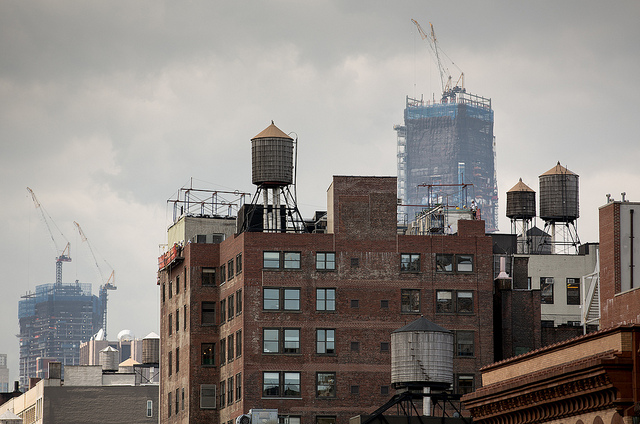
(Source Several Seconds via Flickr Creative Commons)
What Exactly Are Air Rights?
Air rights generally refer to the empty space above a property. But what happens when a building is only six stories high when it could potentially be 32? This is referred to as a building’s “unused potential” and a nearby building or development could tap into that potential.
For example, if Building A is “underbuilt” according to the neighborhood’s zoning code, the developer of nearby Building B can acquire Building A’s unused air space and add it to his own site’s allotment to ultimately construct a taller building. The developer of Building B is acquiring and transferring the air space of Building A’s unused potential.
This transfer of air rights process ensures that the neighborhoods that are the sites of new development are also the neighborhoods that currently have underbuilt lots that can pass on their unused air rights to a new development. In the grand scheme of things, this helps ensure that the whole neighborhood doesn’t get overdeveloped and becomes too dense.
Floor-to-Area Ratio (aka FAR)
One of the most critical factors regulating the height of a new development is a building’s floor-to-area ratio (FAR). FAR is the maximum number of square feet that can be built on a site relative to the square footage of the lot. A building’s FAR, however, can vary depending on the location of the lot (i.e., its zoning district or whether it faces a wide street or narrow street), the use of the building (commercial, residential, community or manufacturing) and whether the building offers a benefit to the public (i.e., public outdoor space or affordable housing units).

(Source: Michael Tapp via Flickr Creative Commons)
How Are Air Rights Transferred?
As anyone who’s ever walked through SoHo on a Saturday knows, New York City is one of the densest and most expensive cities in the world. It should come as no surprise then, that air can be just as coveted and costly as land. As a result, owning and selling air rights can be a hugely lucrative process. There are three primary ways this transfer process occurs.
- Zoning lot mergers are the most common form of air rights transfer and primarily transpire in Manhattan south of Central Park. In a typical zoning lot merger, the owner of underbuilt property with unused development rights decides to link his property with the developer of an adjacent property or lot so that the developer can build a taller building than what would be otherwise allowed by his property’s FAR. The city does not have to approve this kind of transfer and the owner of the unused development rights stands a chance get a huge profit from the sale of the right. In terms of urban planning goals, zoning lot mergers help ensure that the neighborhoods receiving the most new development are also the neighborhoods that have historically been the most underbuilt.
- Special purpose district transfers are another form of air rights transfers. These types of transfers occur in areas deemed by the city to be ‘special purpose districts’ and allow air rights to be exchanged between granting and receiving sites that are not contiguous. The city allows for these sorts of transfers in special cases when there is a particular zoning goal targeting the area. Examples of special purpose districts include the Special West Chelsea district near the High Line and Special Hudson Yards District, among others.
- Landmark transfers are another form of exchanging air rights and involve properties and sites that have been deemed historically or culturally significant by the Landmarks Preservation Commission. In these types of transfers, New York City zoning code allows the exchange of air rights between an LPC-designated landmark and other properties wishing to develop land. The two properties do not necessarily have to be contiguous and in many cases are across the street from each other or even down the block from one another. The underlying principle behind landmark transfers is that new construction occurs in neighborhoods that are less dense due to the unused air rights of underbuilt landmarks. An additional advantage to these types of transfers is that destitute landmarks do not have to sell off property to generate revenue but rather can sell off unused air rights.
In NYC, air can be as expensive as land. Read StreetEasy Blog to learn more about the NYC zoning rules that regulate the transferring of air rights.
Source: What Are NYC Air Rights All About? | StreetEasy Blog
Could a Pedestrian Bridge Connect Jersey to Lower Manhattan??? - Curbed NY
New Jersey can sometimes feel like it's a world away from New York City, but in reality, it's only a few miles from Jersey City to Manhattan—the Hudson River crossing itself is only about a mile. And one Jersey City resident wants to breach that divide in a unique way: with a pedestrian bridge. ( Jersey Digs) Kevin Shane, who came up with the idea, worked with Jersey-based Jeff Jordan Architects to conceptualize plans for a Hudson River crossing called the Liberty Bridge that would begin in JC, cross the Hudson River, and end in Battery Park City. His reasoning: "With the increase in commuter traffic from Jersey City and Hoboken and the unbearable, often delayed mass transit options that are getting worse over time, the bridge could provide a new access point to Manhattan for the hundreds of thousands that go into NYC each day." The renderings, which you can check out below, show a High Line-esque walkway (with various ADA-compliant access points) with benches, plants, and artwork. The bridge would also, according to the site, "provid[e] a 200+ foot view over the Hudson unlike any experience before." Of course, this is all just a proposal—Shane admits the challenges to getting it done are "monstrous"—but it's certainly interesting to consider.
· Liberty Bridge [Official] · The Highline has Nothing on Jersey City's New Pedestrian Bridge [Jersey Digs]
Source: Could a Pedestrian Bridge Connect Jersey to Lower Manhattan? - Pie in the Sky Ideas - Curbed NY
Luxury Sales Slow With 13 Contracts at $4m+ Last Week - The Real Deal
Manhattan’s luxury residential market maintained its relatively tepid pace. A total of 13 contracts were signed this week at $4 million and above, only a slight improvement over last week’s paltry total of 10. The persistently low demand at the high end has also continued to depress prices, with the average unit this week going into contract for $6.3 million, down from $6.6 million last week. The median price, $5.3 million, was also down from last week’s figure of $5.9 million. The one clear positive sign was a strong fall in the average discount from the original asking price, which came in at 2 percent this week, down from a two-year-high of 12 percent last week. The week’s top contract was for the four-bedroom unit M10 at Witkoff Group’s 150 Charles Street in the West Village. The triplex 5,600-square-foot condo features 19-foot ceilings, a fireplace and a 458-square-foot garden. The unit was sold from floors in 2013 for $12.5 million. The developer allowed that buyer to reassign the contract for the unit. 150 Charles started closing over the summer. Construction there is nearly complete. The second most expensive unit of the week was a co-op, 11C at Halstead Property’s 1125 Park Avenue on the Upper West Side. The nine-room corner unit, which features a library, was asking $9 million. It was last purchased in 2005 for $5.3 million, and has since been renovated. [Olshan Realty] – Ariel Stulberg - See more at: http://therealdeal.com/blog/2015/10/05/luxury-sales-slow-with-13-contracts-at-4m-plus-olshan/#sthash.ngKhoDwh.dpuf Source: Olshan Realty | 150 Charles Street | 1125 Park Avenue







